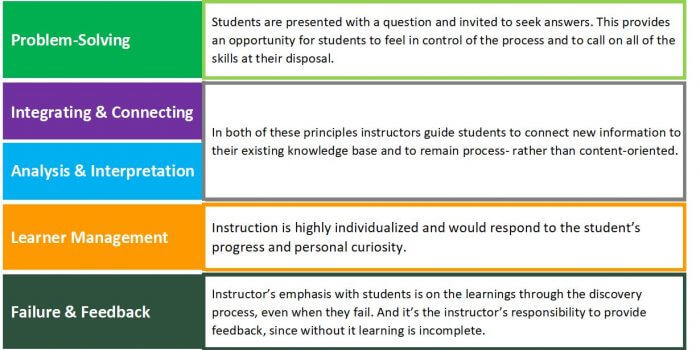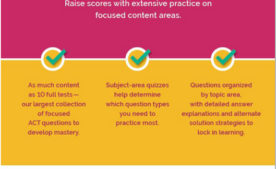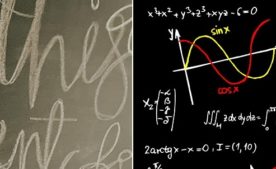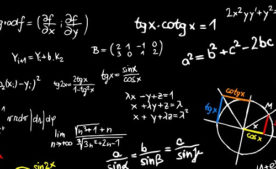We wrote recently about the importance of academic choices in upper elementary and middle school, making the case that students and their families should consider their academic offerings early on and be careful to keep their options open. One important way to do so is to ensure your student is gaining confidence in academic concepts and taking the opportunity to investigate subject areas and explore potential interests.
Building Confidence
Confidence in math and other subjects comes from a sense of genuine understanding. We’ve all had that experience of memorizing something just long enough to get through a test. While this may achieve the grade, it misses the mark when it comes to the true purpose of education and also risks creating a gap that could grow worse. Getting the A is great, but if we forget the material immediately after the test, we’re setting ourselves up for failure as we delve into topics that build on this material.
The Discovery Learning Model
It’s widely accepted that inquiry-based learning models can’t be beat when it comes to true understanding. In a conventional classroom model, groups of students are presented with a rule and then complete practice which reinforces that rule, proving that it is true. In discovery learning, the rule is the destination: students are presented with a problem, they work their way up to solving it, and they are then guided to recognize that they have identified a rule. They will remember the rule better because they understand how and why it works (this also precludes the classic question “when am I ever going to need to know this?”).
Discovery learning was first introduced in the 1960s by Jerome Bruner, who broke the theory down into 5 principles:
Principles of Discovery Learning
A simple physics question may be quite manageable for many students, but label it “algebra” or “physics,” and you’ll find many students throwing in the towel saying that they “haven’t learned this yet.” Leave it open-ended, on the other hand, and students are not limited in their approaches. They can draw on logic and on past experiences without ever realizing they’re doing something that might be called “physics.” This is the hallmark of the Discovery Learning model.
The Obstacles to Discovery Learning in Group Classes
While discovery learning is the ideal educational practice, not all of its principles can be applied successfully in a group setting of adolescents.
The Problem-Solving principle of discovery learning uses a collaborative approach to seeking understanding, and this aspect of group education can support this process. For others, group-based problem-solving tasks creates unnecessary competition, resulting in uneven student engagement, especially when adolescents’ social pressures are at their highest.
Integrating & Connecting and Info Analysis & Interpretation principles provide techniques for instructors to guide students to connect new information to their existing knowledge base and to remain process- rather than content-oriented. However, this often requires that all members of the group are at the same level of knowledge.
The final two principles—Learner Management and Failure & Feedback–present the greatest challenge to students learning in groups. The principle of Learner Management asks instructors to create conditions conducive to success by adjusting the pacing and order of “lessons” to the student’s development. The benefit of this is obvious: it allows the student to learn at their own most effective rate, encourages engagement, and forestalls any shame around missing milestones or failing to keep up with the group.
Failure & Feedback asks instructors to give students the space and support to “get it wrong” and take the path to the correct destination. In group settings, it’s a rare student who’s willing to fail publicly and learning from minor failures now is crucial to setting students up for future success.
How Students Excel with 1:1 Discovery Learning
Discovery-based learning at its best would be highly individualized and would respond to the student’s progress and personal curiosity.
This is where a one-to-one instruction model like Summit’s really shines. A 1984 study comparing conventional classroom, mastery, and tutoring learning models found that “the tutoring process demonstrates that most of the students do have the potential to reach this high level of learning.” The study considered 6 alternate approaches to “solve the two-sigma problem” (close the gap in achievement levels between tutored and classroom-instructed students) but did not find a method that out-performed one-to-one tutoring.
The principles of discovery learning certainly support this. Students working consistently with the same instructor in private sessions develop a comfort level and are more willing to make guesses, critical to the failure and feedback element of discovery learning. By taking leaps, students extend their knowledge. Meanwhile, tutors working consistently with the same student are able to match their instruction to the student’s progress and interests, making it all-around more effective than a blanket curriculum that must by definition accommodate the average.
Why Summit Uses the Discovery Learning Method
Pre-algebra and algebra are fundamental to all math a student will encounter going forward. Trigonometry, calculus, and even geometry will prove an up-hill battle if students do not have a strong algebra foundation from which to build. It is critical to develop an intuitive math sense in 6th and 7th grade: not simply memorization, but true, deep-rooted, natural understanding.
The same holds true for reading and writing. Common Core trends show that less and less emphasis is placed on instruction in literary analysis, yet the skills involved are still tested just as frequently. The support is evolving, but the assessment is not, and students who have not learned how to read and express themselves well will find it challenging to meet expectations in high school English classes. Developing strong, intuitive reading and writing abilities early on is crucial to avoid frustration down the road.
Recall that students begin winnowing down future academic options as early as middle school. A 2017 survey commissioned by Microsoft found that young girls become interested in STEM subjects around the age of 11 and then quickly lose interest when they’re 15.
As parents and guardians, we are also the custodians of our children’s futures until they are ready to take the wheel themselves. We may not wish to influence our children unduly, but we share the desire to provide them with as many options as possible. Helping our students to cultivate a sense of confidence and ability in fundamental subjects is the best way to maximize their future opportunities until they are ready to make their own choices.





















